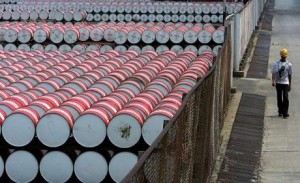 West Texas Intermediate crude fell to the lowest since the beginning of December after the Energy Information Administration reported a larger-than-expected build in refined products inventories, offsetting a sixth straight decline in crude stockpiles. Losses were limited as the coldest US weather in nearly 20 years disrupted operations in US and Canadian refineries, while boosting demand as well. Escalating tension in Libya and Iraq also put a floor under prices.
West Texas Intermediate crude fell to the lowest since the beginning of December after the Energy Information Administration reported a larger-than-expected build in refined products inventories, offsetting a sixth straight decline in crude stockpiles. Losses were limited as the coldest US weather in nearly 20 years disrupted operations in US and Canadian refineries, while boosting demand as well. Escalating tension in Libya and Iraq also put a floor under prices.
On the New York Mercantile Exchange, WTI crude for delivery in February traded at $93.28 per barrel at 15:59 GMT, down 0.42% on the day. Prices plunged to a 5-week low of $92.87 minutes after the release of the report, while days high stood at $94.18 a barrel. The US benchmark added 0.3% on Tuesday but extended its weekly decline to 1% following Wednesdays retreat.
Meanwhile on the ICE, Brent crude for settlement in the same month rose by 0.12% to $107.48 per barrel by 16:00 GMT. Prices shifted in a daily range between $107.94 and $107.01 a barrel. The European benchmark added little over 0.3% on Tuesday and extended its weekly advance to 0.5% on Wednesday.
US crude retreated after a government report showed a further gain in US fuel supplies. The Energy Information Administration said that motor gasoline inventories rose by 6.24 million barrels in the week ended January 3rd to 227 million, exceeding more than two times the median estimate of 10 analysts surveyed by Bloomberg for a 2.5 million increase. Distillate fuel supplies, including diesel and heating oil, jumped by 5.83 million barrels to 125 million, sharply exceeding projections for a 2.25 million build.
Michael Lynch, president of Strategic Energy & Economic Research in Winchester, Massachusetts, commented on the report for Bloomberg: “The big build in products should mean weaker crude prices. The report is bearish given the weak demand numbers. The price may even break $90.”
Total demand for refined products fell by 782 000 barrels per day to 18.2 million, the lowest level since June 9.
US crude oil inventories fell by 2.68 million barrels to 357.9 million last week, a sixth consecutive weekly decline, and were near the upper limit of the average range for this time of the year. The reading came in line with analysts expectations for a drop of 2.75 million barrels. The drop in crude stocks however couldnt offset the build in refined products as analysts saw it as s deliberate withdrawal to reduce taxes at year-end.
Inventories at Cushing, Oklahoma, the biggest US storage hub and delivery point for NYMEX-traded contracts, rose to 40.7 million tons, up from 39.6 million a week earlier.
Refineries operated at 92.3% of their operable capacity, bringing utilization down by 0.1% from the preceding week. Gasoline production increased in the seven days to January 3rd, while distillate fuel production decreased, averaging 9.1 and 5.1 million barrels per day respectively.
Libya, Iraq tension
The oil market, and especially the Brent benchmark, continued to draw support by renewed supply worries in Libya, holder of Africa’s biggest crude reserves. Although nationwide production as much as doubled to over 530 000 bpd after the reopening of the El Sharara oilfield, a rare negotiation success for Prime Minister Ali Zeidan, ongoing tension and supply uncertainty continued to put a floor under prices. Although the field hasnt reached full capacity yet, the countrys output will reach 600 000 bpd by the end of the week, officials said, with the first exports from the field due to be loaded around January 10th from the government-controlled Zawiya port.
A heavily armed autonomy group in eastern Libya invited on Tuesday foreign companies to buy oil from export terminals they previously seized, challenging the central government to use force to stop them.
In an escalation of tension in the African country, the navy opened fire on Monday as a Malta-flagged vessel attempted to approach the rebel-held Es Sider export terminal, threatening it against loading oil from units not under the control of the state-run National Oil Corp.
A warning has been issued by the Libyan defence ministry it would destroy any tankers loading crude oil in the Cyrenaica region, where units are under the control of Ibrahim Jathrans forces, a tribal leader and hero in the 2011 civil war.
Also adding to oils geopolitical premium, sectarian violence in Iraq escalated in the past few days amid fighting in Fallujah and the surrounding Anbar province between Maliki’s Shiite Muslim-led government and Sunni Muslim militants. The country is OPECs second biggest producer.
Coldest weather in 20 years
The market also drew support as cold weather in the US unseen in almost 20 years disturbed operations at processing units, while also boosting demand for heating oil and gasoline as drivers keep tanks filled and run engines longer to warm up.
The freezing temperatures have prompted pipeline operators to reduce flows and refineries to reduce production. Operations at at least five refineries in the US and Canada were affected by the cold weather which cause malfunctions and full closure at some units.
Ric Spooner, a chief analyst at CMC Markets in Sydney, said for Bloomberg: “The market is hanging around support levels and we’ll wait to see what happens with the official inventory figures. The weather will be “positive in terms of an increased use of heating oil.”





